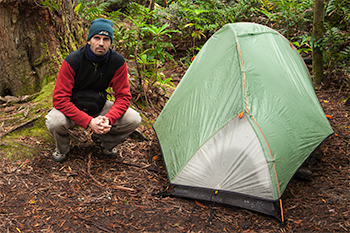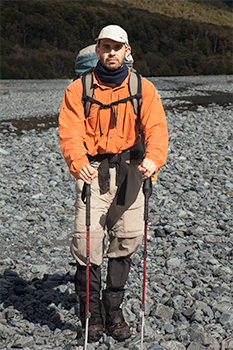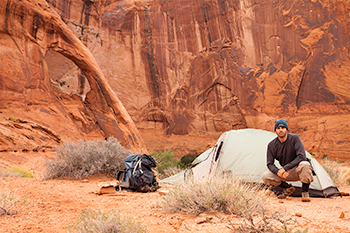PACK WEIGHT (1/8)
One of the most important skills in backpacking is the ability to pack right. And with this I am not referring to how you place your clothes, food, and equipment within your pack for an efficient load transfer while simultaneously having anything you need at hand whenever you need it, which is also a necessary skill. I'm referring to taking with you exactly what you need to fulfill your trip objectives, whatever they are, and leave everything else at home or in your vehicle.
Objectives vary among backpackers. I'm sure we all share a deep appreciation for the
wilderness and the plants and animals that call it home, we all want to come back home
safely, we do not shy away from the risks involved in being far away from civilization,
 and neither are we deterred
from the physical challenge of walking for a long time with
a load on our backs. But that is where similarities stop. Some individuals seek a good
campsite as comfortable as possible in which to relax with friends or family, others seek
the camaraderie of fellow hikers they have never met before, and there are others who
target pushing themselves into breaking speed or endurance records. When in camp, some
hikers read while others fish; some relax and others talk; I try to set camp early, take
my camera, and go in search of good light, while others walk and walk until there is no
light, then go to sleep, and are already hiking before sunrise the next day.
and neither are we deterred
from the physical challenge of walking for a long time with
a load on our backs. But that is where similarities stop. Some individuals seek a good
campsite as comfortable as possible in which to relax with friends or family, others seek
the camaraderie of fellow hikers they have never met before, and there are others who
target pushing themselves into breaking speed or endurance records. When in camp, some
hikers read while others fish; some relax and others talk; I try to set camp early, take
my camera, and go in search of good light, while others walk and walk until there is no
light, then go to sleep, and are already hiking before sunrise the next day.
I've known people that happily carry loads more adequate for elephants so when in camp they can eat, sleep, and play as if they were at home. I've also met others that sacrifice all comforts to go light so they can put big miles every day. And everything in between. All are good strategies, as long as they enable you to reach your objectives. But taking more weight than you should serves no purpose; it takes more effort and more time to get anywhere, you'll be more tired and less capable of enjoying whatever you came to enjoy in the first place, and the extra pounds also put more stress in your body. No one puts dead weight in his pack for the sake of it. As every backpacker knows, take what you need and not a single extra ounce. Easy to say, not so much to do. As everything in life, this is a skill that you slowly master with time. You pay attention and try to learn from experience.
 So minimizing weight is the name of the game. I once read that weighing everything and
writing it down in paper helps a lot in separating what is essential and should stay
from what is accessory and should go. It is a significant effort to weight all your items,
but I've done it and is worth it. Something you always carry around and never use stops
being and old toy you have grown emotionally attached to, and quickly becomes a number of extra
ounces on your spreadsheet that should be eliminated.
So minimizing weight is the name of the game. I once read that weighing everything and
writing it down in paper helps a lot in separating what is essential and should stay
from what is accessory and should go. It is a significant effort to weight all your items,
but I've done it and is worth it. Something you always carry around and never use stops
being and old toy you have grown emotionally attached to, and quickly becomes a number of extra
ounces on your spreadsheet that should be eliminated.
The main reason why I backpack is because it allows me to get into places and situations in which I am in peace with myself, completely relaxed, and marvelled by the beauty of the natural world. Living the present, and enjoying it. And looking at the world through the viewfinder of my camera is invaluable in that regard, as when searching for good light and good compositions is when I more easily achieve that sensation. In those situations I see, hear, smell, and notice details I otherwise do not. Hours fly like minutes, I forget to eat, and I find my purpose in life. For me those moments are it. So the camera stays. Because after looking at the numbers below, anybody would quickly reach the conclusion that the photo equipment should not be in my backpack. It is not only because of its own weight, but because its extra weight starts a chain reaction. More weight implies a bigger and more robust backpack with a better suspension to carry it, heavier boots to control the loads, more effort and hence more burnt calories, so more calories to replace which is the same as more food which equals more weight, and so on and so on. But the camera stays.
Below is the list of everything I would take on a default backpacking trip, which corresponds to a week long foray into Sierra Nevada (CA, USA) in late spring or early autumn, when the temperatures are comfortable during the day but fall slightly below freezing at night, and although the weather is usually dry, there is a good chance of having a 24 or 48 hour long rain or snowstorm. For every trip, and based on the trip length and weather forecast, I add or remove a few items as required, but my starting point is what I show here.
I have divided all items I take with me into several categories: essentials, clothes on body, clothes in pack, accessories, food, and photo equipment. I also include a last group called replacements with items that generally do not make it into my backpack but that I may throw in if conditions warrant it. Each category opens up into its own page with a detailed description of every item in it.

Weight (pounds & ounces) |
|
|
|
13 lb |
11.4 oz |
||
8 lb |
14.3 oz |
||
6 lb |
2.1 oz |
||
4 lb |
1.1 oz |
||
12 lb |
8.7 oz |
||
TBD |
|||
N/A |
Essentials - Clothes on Body - Clothes in Pack - Accessories - Photography - Food - Other Items